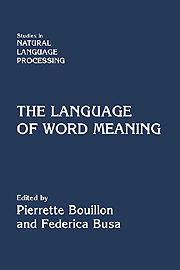Book contents
- Frontmatter
- Contents
- List of Contributors
- Preface
- Introduction: Word Meaning and Creativity
- Part I Linguistic Creativity and the Lexicon
- Part II The Syntax of Word Meaning
- Part III Interfacing the Lexicon
- Part IV Building Resources
- 18 Introduction
- 19 Generative Lexicon and the SIMPLE Model: Developing Semantic Resources for NLP
- 20 Lexicography Informs Lexical Semantics: The SIMPLE Experience
- 21 Condensed Meaning in EuroWordNet
- Index
18 - Introduction
Published online by Cambridge University Press: 07 October 2011
- Frontmatter
- Contents
- List of Contributors
- Preface
- Introduction: Word Meaning and Creativity
- Part I Linguistic Creativity and the Lexicon
- Part II The Syntax of Word Meaning
- Part III Interfacing the Lexicon
- Part IV Building Resources
- 18 Introduction
- 19 Generative Lexicon and the SIMPLE Model: Developing Semantic Resources for NLP
- 20 Lexicography Informs Lexical Semantics: The SIMPLE Experience
- 21 Condensed Meaning in EuroWordNet
- Index
Summary
The goal of this part of the volume is best explained by the recent interest in evaluating which lexical semantics resources are available for Natural Language Processing (NLP) and whether a methodology can be established for building large-scale semantic knowledge-bases.
The papers address the topic of understanding and structuring word meaning from the particular perspective of building NLP systems. Here, the problem of how to represent word meaning has fairly strict requirements: It affects the choice of particular data structure as well as the specific architectural requirements for a computational lexicon.
All of the contributions in this section present practical questions and dilemmas that are not usually faced in theoretical research. The first issue is one of methodology: Can existing semantic resources (viz. ontologies) be reproduced by identifying a consistent set of criteria? This is an important question, because a positive answer would mean that we have achieved an understanding of how to model conceptual knowledge independently of domains and people's intuitions.
The second issue is whether existing lexical semantics frameworks provide the basis for developing a large-scale resource on systematic grounds. Although related to previous question this problem is also relevant to the notion of “scalability.” In other words, if a particular framework makes certain claims about how meaning should be structured to account for a limited number of linguistic facts, is the suggested structuring sufficiently general to cover a large corpus? Furthermore, were that corpus to become even larger, would the lexicon scale up easily to cover the newer data? More or less explicit answers are found in the different contributions.
- Type
- Chapter
- Information
- The Language of Word Meaning , pp. 331 - 332Publisher: Cambridge University PressPrint publication year: 2001



